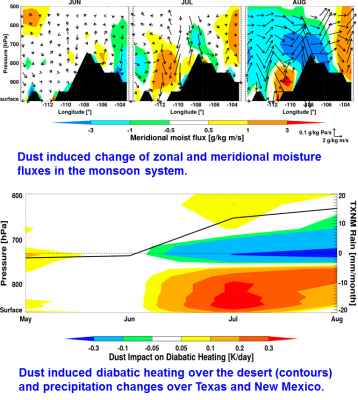Desert Dust Intensifies Summer Rainfall in U.S. Southwest
Dust is more than something to be brushed off the furniture. Scientists at Pacific Northwest National Laboratory (PNNL) found that dust kicked up from the desert floor acts like a heat pump in the atmosphere, fueling the annual climate system called the North American Monsoon. The dust increases precipitation by up to 40 percent during the summer rainy season in Arizona, New Mexico, and Texas. Their study, the first on the U.S. Southwest summer monsoon, found that the heat pump effect is consistent with how dust acts on West African and Asian monsoon regions. The research was published in Atmospheric Chemistry and Physics.
During June, July, and August each year, the U.S. Southwest and northern Mexico experience a climate system known as the North American Monsoon, characterized by surface heat and episodes of heavy rainfall. This region receives over 70 percent of its annual precipitation in just 3 months. PNNL researchers, using sophisticated simulation techniques, investigated the effect on the atmosphere of dust emitted from the U.S. Southwest deserts to fuel the intensity of the monsoon system. The research team studied both solar heat and thermal heat from the Earth and other effects of dust. Model-simulated dust mass concentration was evaluated using surface measurements over Arizona from the IMPROVE network, 100 sites in the United States that measure the chemical make-up of aerosols. They evaluated aerosol optical depth simulations using data from AERONET and satellite measurements from MISR near the dust source region.
Researchers simulated 15 years with dust emissions and 15 years without dust emissions, using the date range 1995-2009 and the Weather Research and Forecasting model coupled with chemistry, known as WRF-Chem, then compared the results with observations. The 15-year simulations were used to average out natural interannual climate variability. The simulations showed the dust effect prompts a 45 percent increase in aerosol optical depth near the deserts, causing increased precipitation. These findings show a similar effect of dust on the North American Monsoon as found with the Asian and West African monsoon systems.
“We found that dust heated the lower atmosphere by 0.3 Kelvin/day, which strengthened low-level north-south winds,” said Dr. Chun Zhao, lead author and climate scientist at PNNL. “Strengthening the winds leads to a 10-40 percent increase in precipitation in the monsoon. This is a significant effect that has not been well understood."
As the climate warms, more regions of the world will be affected by drought. Increased desert regions and dry land produce more dust that gets lofted into the atmosphere. These dust particles absorb sunlight and act as a heat pump, attracting moisture from nearby oceans and increasing seasonal rainfall. PNNL researchers are the first to investigate this effect in a dry region of the United States where water resources are limited. Understanding how dust contributes to atmospheric heating is important for predicting drought and rainfall patterns in this region and others in the world with rising populations.
DOE scientists at Pacific Northwest National Laboratory found that dust kicked up from the desert floor acts like a heat pump in the atmosphere, fueling the annual climate system called the North American Monsoon (NAM). The NAM occurs during June, July, and August each year over the U.S. Southwest and northern Mexico, and is characterized by surface heat and episodes of heavy rainfall. The region receives over 70 percent of its annual precipitation in these 3 months. The researchers, using sophisticated simulation techniques, investigated the effect on the atmosphere of dust emitted from the U.S. Southwest deserts to fuel the intensity of the monsoon system. The dust increases precipitation by up to 40 percent during the summer rainy season in Arizona, New Mexico, and Texas. Their study, the first on the U.S. Southwest summer monsoon, found that the heat pump effect is consistent with how dust acts on West African and Asian monsoon regions. Understanding how dust contributes to atmospheric heating is important for predicting drought and rainfall patterns in this region and others in the world with rising populations.
This research was supported by the U.S. Department of Energy’s Investigation of the Magnitudes and Probabilities of Abrupt Climate TransitionS (IMPACTS) project. The research was performed by Drs. Chun Zhao, Xiaohong Liu, and L. Ruby Leung of PNNL. The research used computing resources from the National Energy Research Scientific Computing Center, supported by the Office of Science, U.S. DOE.

